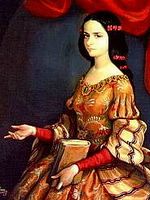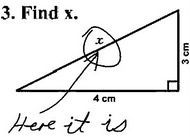Menticia gets interested in history.
I totally love being a mentor. Menticia really cheered me up on Friday when I was a little low because my daughter Melina and her swain are not coming home. This will be the first time ever I don't lay my eyes on Melina at the darkest time of the year - the first time ever she won't be here on my birthday - that she won't light Hannukah candles with me.
I knew this time was coming, but forewarning doesn't actually help much.
Anyway, I picked Menticia up at school and saw that, for once, she had gotten enough sleep. Too often she watches tv with her sibs way late into night. This time, her eyes were dancing and her little body was full of bounces. I wish she got enough sleep more often.
We went off to one of her favorite restaurants for her customarily huge "snack."
I was telling her about my Spanish conversation teacher, who is a chicano, more specifically a tejano:
Tejano history dates back to 1731, when 15 families from the Canary Islands came to settle in San Antonio in what was then northeastern Mexico, which in turn was under Spanish rule. ... The Tejanos were an independent frontier people who developed a ranching community and a culture that was separate from the rest of Mexico. ...(Well, I didn't tell her all that - it's googled from the National Geographic.)
Things changed in 1821 as Mexico gained independence from Spain. The new federalist Texas government invited U.S. settlers to Mexican-controlled Texas. The Tejanos, recognizing the economic benefits of this immigration, welcomed the new settlers.
The territory was rich in fertile land. By 1830 there were 30,000 U.S. settlers and slaves living in Texas, compared to just 4,000 Tejanos.
In 1834 the new president of Mexico, Antonio Lopez de Santa Anna, abolished the federalist system and concentrated power in Mexico City. Both Tejanos and the Anglo settlers saw this as a severe blow to Texas sovereignty [and] joined forces, and by the end of 1835, they had succeeded in driving all Mexican soldiers out of Texas.
In late 1835 the Anglo-Tejano rebels defeated and evicted Mexican forces from the Mission San Antonio de Valero ... later known as the Alamo.
While recognizing that the Anglo settlers drove the independence movement, some historians argue it was the Tejanos who envisioned the revolution's framework. The Tejanos, these historians contend, had been fighting for independence for such a long time that they simply invited the settlers to the cause.
"The myth is that Anglos brought liberty to Texas, when in reality Tejanos initiated the struggle with the authoritarian government of Santa Anna in Mexico"
Driven Out
At the 1845 convention to admit Texas to the United States ... more than a million acres of land had been transferred from Tejanos to Anglo-Americans.
Later settlers who arrived in Texas were unaware of the Tejanos' contribution to the territory's independence, and many hated all people of Mexican descent. The new settlers drove many Tejano people from their homes.
When the classical versions of Texas history were written in the late 19th century and early 20th century, the Tejanos were virtually erased. More.
Interestingly Menticia told me: "They got California from us, too."
I said, "Menticia, who's us?" (We mentors are supposed to talk to our kids about their heritage and ethnic identity.)
For the first time ever she said "Mexico!" and sort of pumped her fist as for a soccer team.
I said, "hmm, but you live here in the United States, isn't that part of your team?"
[Pause.] "I'll root for Mexico one month and then root for the U.S. the next month! I'll alternate!"
I think that's a good compromise. She and her older sister and brother were all born in Mexico, even though they came here when Menticia was only one year old. I'm happy to see her interested in history and in her own past, something she's been markedly bored by in previous conversations.
What do you think?
We then had a discussion of the English idiom know which side your bread is buttered on. I see it was used in the year 1546 by John Heywood: 'I knowe on whiche syde my breade is buttred.'
The rest of our afternoon: chronicled tomorrow.
Technorati Tags: Mexico, Mexican, History, Mentoring, Tejano, Chicano
Labels: mentoring



 A few of my daughter
Melina's great posts:
A few of my daughter
Melina's great posts:








3 Comments:
You sound like a wonderful mentor..A lot of these kids need to explore their identity in a safe environment which is what you are helping her to do..
Bravo!
Minerva
And Michele sent me today...
I think that Menticia is a lucky girl to have you as her mentor.
All children who come to the US from another country need to be made aware (on an ongoing basis) of their heritage and given the correct history of their people. And they should be allowed to assimilate and absorb our culture also - and learn our language!
Unfortunately, he who conquers, gets to write the history books.
I truly enjoy reading your blog every day.
Etcetera
Post a Comment
<< Home